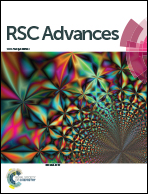Oxidative dehydrogenation of thiols to disulfides at room temperature using silica supported iron oxide as an efficient solid catalyst†
Abstract
Selective transformation of thiols to disulfides by means of oxidative dehydrogenation has been described using silica supported iron oxide under base- and solvent-free reaction conditions at room temperature in an open atmosphere. The easiness of catalyst preparation, green reaction conditions, easy separation of the formed products and catalyst from the reaction mixture, and recyclability of the catalyst, are the most attractive facets of our synthetic procedure which, being ecofriendly, will find immense applications in academic and industrial sectors.


 Please wait while we load your content...
Please wait while we load your content...